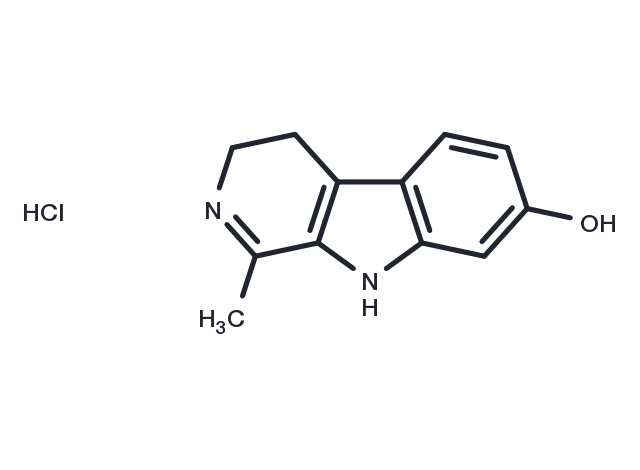store at low temperature
Powder: -20°C for 3 years | In solvent: -80°C for 1 year

Harmalol hydrochloride (Harmidol hydrochloride) is a β-carboline alkaloid that can be extracted from the seeds of Peganum harmala L. Harmalol hydrochloride is the major metabolite of Harmaline and significantly inhibits dioxin-mediated induction of CYP1A1 at both transcriptional and post-translational levels. Harmalol hydrochloride showed vasorelaxant activity in isolated rat thoracic aortic preparations preconstricted with phenylephrine or KCl. Harmalol hydrochloride has antioxidant activity.

| Pack Size | Availability | Price/USD | Quantity |
|---|---|---|---|
| 1 mg | In stock | $ 60.00 | |
| 5 mg | In stock | $ 147.00 | |
| 10 mg | In stock | $ 218.00 | |
| 25 mg | In stock | $ 369.00 | |
| 50 mg | In stock | $ 543.00 | |
| 100 mg | In stock | $ 776.00 |

| Description | Harmalol hydrochloride (Harmidol hydrochloride) is a β-carboline alkaloid that can be extracted from the seeds of Peganum harmala L. Harmalol hydrochloride is the major metabolite of Harmaline and significantly inhibits dioxin-mediated induction of CYP1A1 at both transcriptional and post-translational levels. Harmalol hydrochloride showed vasorelaxant activity in isolated rat thoracic aortic preparations preconstricted with phenylephrine or KCl. Harmalol hydrochloride has antioxidant activity. |
| Targets&IC50 | H4 human glioblastoma:23.7 μM(IC50s), MAO-A:0.66 μM, DYRK1A:0.63 μM |
| In vitro |
Harmalol (0.5-12.5 μM) reduces increases in the levels of the cytochrome P450 (CYP) isoform CYP1A1 induced by 2,3,7,8-tetrachlorodibenzo-p-dioxin (TCDD) in HepG2 cells and prevents TCDD-induced activation of the aryl hydrocarbon receptor (AhR) in guinea pig hepatic cytosolic extracts.[1] Harmalol (25 μM) reduces glutamate-induced cytotoxicity, cytochrome c release, caspase-3 activation, and the production of reactive oxygen species (ROS) in PC12 cells.[2] |
| Synonyms | Harmidol hydrochloride |
| Molecular Weight | 236.7 |
| Formula | C12H13ClN2O |
| CAS No. | 6028-07-5 |
store at low temperature
Powder: -20°C for 3 years | In solvent: -80°C for 1 year
DMSO: 90.0 mg/mL (380.2 mM), Sonication is recommended.
You can also refer to dose conversion for different animals. More
bottom
Please see Inhibitor Handling Instructions for more frequently ask questions. Topics include: how to prepare stock solutions, how to store products, and cautions on cell-based assays & animal experiments, etc.
Harmalol hydrochloride 6028-07-5 Metabolism oxidation-reduction Antioxidant P450 Harmidol hydrochloride Harmidol Hydrochloride Harmalol Hydrochloride inhibitor inhibit
